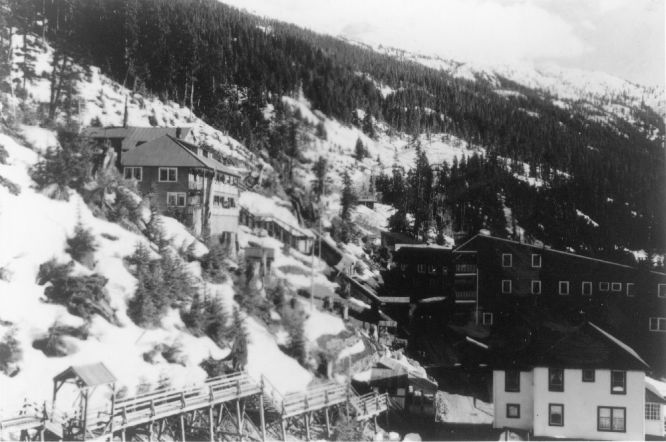Pioneers

Cyril Burton North
Photo - Priemer Mines 1930
One of the most outstanding men in the north was Cyril Burton North.
Born in Nova Scotia, he graduated in engineering and became a member of the Professional Engineers Association and the Canadian Institute of Mining and Metallurgy.
In 1914 he went overseas as commander of the lst Tunnelling Company and became commander of the Third Division Engineers.
After the war, he became manager of the Dolly Varden mine and railroad at Alice Arm, later being placed in charge of the B.C. Silver mine, about half-a-mile up the mountain above the Premier.
He was one of those ambitious, daredevil, open-minded type of men who could get more work out of his employees than anyone. This was because he treated them as equals, worked with them and, when the time came, played with them.
Fine horses such as this one would be used for single travel to various mining camps.Major, or Cy, as he was known, would ride the 18 or more miles to Stewart each week on the finest horse in the district. Man and animal made an admirable team as, even by that time, people were traveling to and from the mines by car or stage.
One day costumers of a store were startled by a loud noise. There, to everyone's surprise, was the major--still astride his steed, and coming up the steps and into the store. "I want the best bottle of Scotch that will fit snug into my saddlebag," he said with a smile.
He tried a few and he settled for a flat LCB two-crown, imperial quart. The counter check was filled out with permit number, it was handed up to him for signature, collected the cash; then with a struggle, he pushed the large bottle into the saddlebag (out of sight, as he had to pass through Alaskan customs), patted his horse and made his departure.
The wooden sidewalk was three steps down, also old and slippery. The horse took its time, then jumped the stairs, hit the sidewalk with its hind hooves and leaped the other steps to the road in jig time.
The major came into the store on horseback many times after that, once giving his mount two bottles of beer in a washbasin as a reward.
The next spring, the major showed up in a new sports car which we named the "Red Devil."
One night, while Ozzie Hutchings was on the way to the Premier, and as he was rounding a hairpin turn, he came face to face with the Red Devil, roaring down the wrong side of the road, hugging the mountain.
Premier Miner in the winter, 1937. Ozzie's driver, Ed O'Brian, just managed to pull over to the left and avoid a crash as the devil thundered by. By the time he stopped, the left rear wheel was over the edge. Ed jammed on the brakes which, happily, held, and Ozzie got out to add his weight to the front of the car until the ladies were able to climb out.
All were okay and, with a few rocks jammed under the wheel, they were able to gain sufficient traction to get the car back onto solid ground. But it had been a close call, as the drop was several hundred feet. That was the last time Ozzie and his wife ever went to the Premier mine.
The major was coming to town more often at that time, as he was dating one of our popular nurses. They married and moved to Vancouver, then on to the Duthie mines at Smithers.
In 1933 he took charge of B.C. Nickel at Choate, B.C. During the Second World War he was promoted and, as Colonel North, was assigned to Gibraltar to oversee the construction of a huge, underground hospital, complete with road, storehouses and artesian wells.
During the First World War he had been wounded twice, decorated with the DSO and MC, awarded the Bar to his DSO, and mentioned in dispatches five times. An expert rock worker, he was widely known in mining circles as one of the most experienced tunnel men in Canada.
This is why he became chief of the engineering staff during construction of the First Narrows tunnel, which delivers water from the Capilano River to Vancouver.
He also became a consulting engineer for the Kemano Aluminum Company at Kitimat, his most outstanding achievement was his role as project manager during the blasting of the notorious Ripple Rock in Seymour Narrows, in 1958; the largest peacetime, non-nuclear explosion up until that time.
NEXT IAN MCLEOD